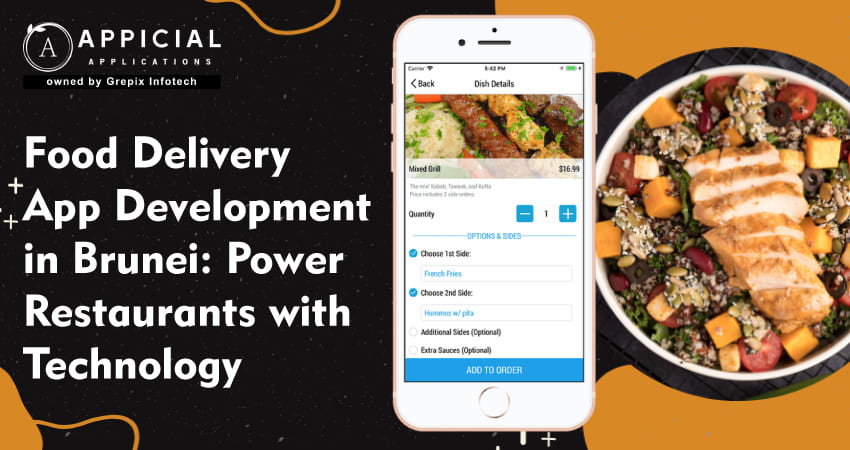
Food Delivery App Development in Brunei: Power Restaurants with Technology
Restaurants in Brunei face a crossroads.
Dine-in traffic rises and falls. COVID changed habits fast. Now, many people want food at home. They want convenience. They want speed. They want variety.
Delivery apps in Brunei are becoming essential. Some restaurants lose customers if they don’t adapt. Others thrive by embracing a food delivery app.
A well-built food delivery app can help restaurants manage orders, optimize deliveries, track inventory, and engage users.
Models from Grubhub, DoorDash, and others inspire local entrepreneurs. They see how Grubhub delivery works abroad. They study DoorDash food delivery systems. They think: Can we build something similar in Brunei?
This article shows how. It shows what features matter. It shows costs. It shows success. It ends by showing how Appicial Applications can help you make a reliable food delivery app development.
This blog tells a story of restaurants in Brunei adopting technology via food delivery app development. It explains demand, strategies and challenges. It compares models like Grubhub delivery in Brunei and DoorDash food delivery in Brunei. It walks through building food ordering apps, picking features, and choosing a food delivery app development company. There is a case study showing what Appicial Applications achieved. In the end, FAQs answer common questions for restaurateurs and developers in Brunei.
The Story of Demand in Brunei
In early 2020, restaurants in Brunei saw dine-in collapse due to restrictions. Many closed or reduced hours. At the same time, delivery apps like GoMamam saw daily orders jump. Before, orders per day ranged around 60-80. After, they rose to 170-200.
GoMamam had about 11,000 downloads early on.
Brunei’s online food delivery market is growing steadily. The “Online Food Delivery” market is projected to reach around US$42.41 million in 2024.
The Restaurant Delivery part of the Meal Delivery sector is expected to hit US$1.79 million in revenue in 2024.
That shows the market is not huge yet. But it is fast. User penetration is rising. People expect better delivery, more apps, and faster service.
Restaurants that ignore technology risk being left behind.
Models to Emulate: Grubhub, DoorDash & Food Ordering Apps
Models from abroad teach lessons.
Grubhub Delivery Style
Grubhub connects users with many restaurants. It lists menus, handles payments, ratings, and drivers. Brunei can copy that model. A local food delivery app similar to Grubhub delivery in Brunei could offer many restaurant partners.
DoorDash Food Delivery Template
DoorDash focuses on fast delivery. It invests in logistics, “dark kitchens”, partnering with drivers. A DoorDash delivery app, Brunei-style operation would center on delivery speed and reliability.
Food Ordering Apps & Their Variants
“Food ordering apps” often focus less on the driver side, more on ordering, notifications, and kitchen processing. Many Brunei restaurants use simple ordering apps or manual systems. Upgrading to full delivery apps helps reduce errors, improve tracking, and increase order volume.
Key Components of Food Delivery App Development
Building a food delivery app means many moving pieces.
- Restaurant Partner Module: menus, item availability, prep time, pricing.
- User (Customer) Module: search, order, payment, delivery tracking, reviews.
- Courier / Driver Module: accept orders, GPS navigation, schedule, and earnings.
- Admin Dashboard: restaurant management, delivery logistics, promotions, analytics.
- Notifications & Real Time Tracking: users want to see where food is. Delays, ETA.
For features like in Grubhub delivery in Brunei-style systems: multi-restaurant listing, ratings, favourites.
For the DoorDash delivery app in Brunei, style: surge pricing, scheduled orders, and real-time driver dispatch.
Challenges & Considerations Unique to Brunei
Some challenges are universal. Others are local.
- Geography: Brunei is small. Distances are short. But delivery road conditions matter. Traffic during peak hours in Bandar Seri Begawan slows things down.
- Population density: Less dense in rural areas. Fewer orders are far from central areas. Courier cost per order rises when the distance is long.
- Payment options: Many users prefer cash. Others use local bank cards. The payment gateway must support local banking, maybe mobile wallets.
- Restaurant capacity: Smaller restaurants may have limited kitchen space. They may not handle large order volumes or complex menu items.
- User expectations: Many have used delivery apps during COVID. They expect speed, tracking, good packaging, and reliability. Subpar apps receive negative reviews.
- Regulation: Food safety, licensing, business permits, and insurance for delivery drivers or riders.
What are the Steps in Developing a Food Delivery App in Brunei
Here’s what needs to happen.
Market Research
Talk to restaurant owners. Survey customers. Study GoMamam, ONZ, Ta-Pow, HeyDomo. Understand what works. Which food delivery apps are popular now in Brunei? Where are the gaps?
Define App Type and Strategy
Decide: full delivery (own couriers), partner with local dispatch, or pure marketplace. Decide commission model. Decide the fee per delivery.
Pick whether your food delivery app development should mimic Grubhub delivery or DoorDash food delivery, or mix styles.
Design & UX
Design must be simple. Users must find menus fast. Checkout must be smooth. Tracking must be visible. Offer rating and feedback. Multilingual UI (at least English and Malay).
Build & Integrate
Develop backend, mobile apps (iOS, Android). Integrate payment gateways that work in Brunei. Integrate mapping & navigation. Set up restaurant dashboards. Set up courier apps.
Testing & Quality Assurance
Test the app under many conditions. Low network, bad signals, incorrect GPS. Test high load (many orders). Test cancellations, refunds, and restaurant delays.
Launch & Marketing
Soft launch in one area. Collect feedback. Fix bugs. Expand. Use promos, local influencers, and restaurant partnerships.
Cost & Revenue Insights
Development cost and revenue model are core to business viability.
Estimated Costs
Depending on scope, a basic food delivery app development in Brunei may cost USD 20,000-40,000. With more features (live tracking, driver management, multi-restaurant), costs can reach USD 60,000-120,000+.
Costs include design, development, backend, servers, map APIs, and payment gateway setup.
Revenue Streams
- Commission per order from restaurants.
- Delivery fees from customers.
- Surge pricing or peak fees.
- Featured listings or promotions for restaurants.
- Subscription models for premium features (priority listings, better visibility).
With rising user penetration, revenue per user (ARPU) could increase. Brunei’s online food delivery user penetration is projected to grow. Revenue estimates for online food delivery in Brunei are expected to increase year on year.
Case Study How Appicial Applications Helped a Client?
What did the client need?
A medium-sized restaurant chain in Brunei wanted better reach. They had a delivery service in-house. But reliability was low. Customers often complained about late delivery, order mix-ups. They wanted a full food ordering app solution. They also wanted driver tracking.
They wished for something like Grubhub delivery in Brunei standard. Or close to the DoorDash delivery app, Brunei style.
Also Read: Food Delivery App Development in Bahrain: Expand Culinary Businesses Online
How did Appicial Applications approach the project?
Appicial Applications audited the restaurant’s operations. They built a custom food delivery app. It had modules: user app, restaurant dashboard, courier app, and admin panel. They added features: menu management, order tracking, payments, and promotions.
They optimized for local context: small delivery zones, multiple languages, and local payment gateways. They made UI simple. They did rigorous testing.
What was the result?
The restaurant saw orders double within two months of launch. Customer complaints dropped by over 60%. Delivery times came down by 30%. Drivers were happier. The restaurant chain expanded to 3 more branches.
Revenue per user improved. Restaurants listed in the app got more orders. Users liked tracking and feedback features.
Trends Shaping Food Delivery Apps in Brunei
- Live tracking is now expected. GoMamam already uses GPS tracking.
- Tiered delivery rates based on distance. In Brunei, GoMamam used $3 for <7 km, $4 for 7-11km, etc. That model is popular.
- Higher app downloads and daily order growth. GoMamam saw many downloads and active users.
- User experience & UI matters: speed, simplicity, and reliability are differentiators.
- Restaurant tech: POS systems integrating with delivery apps, kitchen display, and order management.
Conclusion
Restaurants in Brunei stand to gain a lot from delivery apps. Technology can transform how they take orders. It can speed delivery. It can improve customer satisfaction. It can grow revenue.
Building a food delivery app, whether inspired by Grubhub delivery, DoorDash food delivery, or a mix, offers clear benefits. But it also needs careful planning: design, cost, local adaptation, and reliable execution.
For restaurateurs looking to compete or expand, choosing the right food delivery app development company is vital. One that understands Brunei’s geography, consumer preferences, payment systems, and food safety.
Appicial Applications is such a company. They have built food delivery apps that work. They balance global best practices (from models like Grubhub delivery and DoorDash food delivery) with local sensitivity. Their apps have high reliability, fast delivery, and good UX.
If you want to power your restaurants with technology, build a strong food ordering app or delivery app, scale with features, and delight customers, partner with Appicial Applications. Let them help you turn the demand in Brunei into sustainable growth.
FAQs
Author's Bio

Vinay Jain is the Founder at Grepix Infotech and brings over 12 years of entrepreneurial experience. His focus revolves around software & business development and customer satisfaction.
Back to blog list




